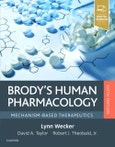The 6th Edition of this easy-to-use text is now fully up to date with:
- NEW chapter devoted entirely to pharmacogenomics and personalized medicine. - NEW chapter on cannabinoids and their use for pain and other disorders, in light of recent legalization in many states. - NEW chapters on recent developments in the treatment of Alzheimer's disease, ADHD and the latest treatments for HIV. - NEW section on pain management. - NEW section in each chapter covering "Clinical Relevance for Healthcare Professionals" that provides important information specific to physical therapists, dentists and dental hygienists, and many other medical professionals.
Plus these student-friendly features:
- A new organizational approach, focusing on integration and systems-based learning. - Contributions from leading faculty who cover the most important aspects of pharmacology necessary for a basic understanding of the subject, including concepts, clinical applications, and side effects. - USMLE-style self-assessment questions at the end of every chapter, answers and rationales in the Appendix. - Online access to Student Consult?where you'll find the complete contents of the book, fully searchable...150 USMLE-style questions...and more.
Table of Contents
Section 1 Mechanisms of Drug Action and Therapeutic Principles
1. Introduction, Terminology
2. Pharmacodynamics: Drug Targets (Receptors, Enzymes, DNA, etc)
3. Pharmacokinetics
4. Pharmacogenomics
5. Drug Discovery, Development, and Regulation
Section 2 Chemical Mediators and Drugs Affecting Autonomic and Neuromuscular Synapses
6. Introduction to the Peripheral Nervous Systems and Drugs for Peripheral Disorders
Cholinergic Drugs
7. Muscarinic Agonists and Their Clinical Uses
8. Muscarinic Antagonists and Their Clinical Uses
9. Nicotinic Agonists and Their Clinical Uses
10. Nicotinic Antagonists and Neuromuscular Blocking Drugs
Adrenergic Drugs
11. Adrenergic Agonists and Their Clinical Uses
12. Adrenergic Antagonists and Their Clinical Uses
Section 3 Drug Treatment for Disorders Affecting the Central Nervous System
13. Introduction to the CNS and Drugs Affecting the Brain
Neurodegenerative Disorders
14. Drug Therapy for Alzheimer's Disease and Other Cognitive Disorders/Dementias
15. Pharmacotherapy of Basal Ganglia Disorders: Parkinson's Disease and Huntington's Disease
16. Drug Therapy for Psychoses and Bipolar Disorder
17. Drug Therapy for Depression and Anxiety
18. Drug Therapy for the Management of Attention Deficit Hyperactivity Disorder
19. Drug Therapy for Insomnia and the Hypersomnias
20. Drug Therapy for Managing Obesity and Eating Disorders
21. Treatment of Seizure Disorders
22. Drug Therapy to Control Spasticity Disorders
23. Ethanol, Other Alcohols, and Drugs for Alcohol Use Disorder
24. Illicit Psychoactive Compounds and Substance Use Disorder
Section 4 Drug Therapy for Pain Management
25. Introduction
26. General Anesthetics
27. Local Anesthetics
28. Opioid Analgesics
29. Nonsteroidal Anti-inflammatory Agents and Acetaminophen
30. Cannabinoids
Section 5 Treatment of Inflammatory, Allergic and Immunologic Disorders
31. Drug Therapy for Migraine Headache
32. Drug Therapy for Gout and Hyperuricemia
33. Drug Treatment for Allergic Reactions
34. Immunosuppressants for Autoimmune Disorders and Organ Transplantation
35. Drug Therapy for Rheumatoid Arthritis
Section 6 Drug Treatment for Cardiovascular Diseases
36. Introduction to The Cardiovascular System and the Regulation of Blood Pressure and Heart Rate
37. Overview of Hypertension Management and Drugs that Decrease Sympathetic Tone
38. Diuretics and Drugs that Affect Volume and Electrolyte Content
39. Drugs Affecting the Renin-Angiotensin-Aldosterone System
40. Calcium Channel Blockers
41. Vasodilators
42. Drug Therapy for Hyperlipidemias and Atherosclerotic Cardiovascular Disease
43. Drug Therapy for Myocardial Ischemia and Angina Pectoris
44. Treatment of Heart Failure: Cardiac Glycosides, Phosphodiesterase Inhibitors and Other Agents
45. Antiarrhythmic Drugs
46. Anticoagulant, Antiplatelet and Thrombolytic Agents
47. Drug Therapy for Hemophilia and the Anemias
Section 7 Treatment of Endocrine Disorders
48. Introduction to Endocrine Pharmacology
49. Treatment of Hypothalamic and Pituitary Disorders
50. Treatment of Adrenalcorticosteroid Disorders
51. Female Hormone Regulation
52. Androgens, antiandrogens and their clinical uses
53. Drug Therapy for the Management of Diabetes
54. Drug Therapy for the Management of Thyroid Disorders
55. Calcium Regulating Hormones and Agents Affecting Bone
Section 8 Chemotherapy
Infectious Diseases
56. Principles of Antimicrobial Use
57. Bacterial Cell Wall Synthesis Inhibitors
58. Inhibitors of Protein Synthesis
59. Drugs that Target DNA
60. Antimycobacterial Drugs and the Treatment of Tuberculosis and Leprosy
61. Drug Therapy for Resistant Organisms
Parasitic Diseases
62. Antifungal Agents
63. Antimalarial and Other Antiprotozoal Agents
64. Antihelmintics
Viruses
65. Drug Therapy for non-HIV Viral Infections
66. Drugs for HIV and Related Opportunistic Infections
Cancer
67. Introduction and Therapeutic Principles
68. Cytotoxic Agents
69. Targeted Agents
Section 9 Special Considerations
70. Therapeutic Use of Hematopoietic Growth Factors, Vitamins and Minerals
71. Gastrointestinal Disorders and Their Treatment
72. Pharmacological Treatment of Asthma and COPD
73. The Role of Neutraceuticals and Natural Products
74. Essentials of Toxicology
75. Therapeutic Considerations for Pregnant, Pediatric, Geriatric and Obese Individuals








